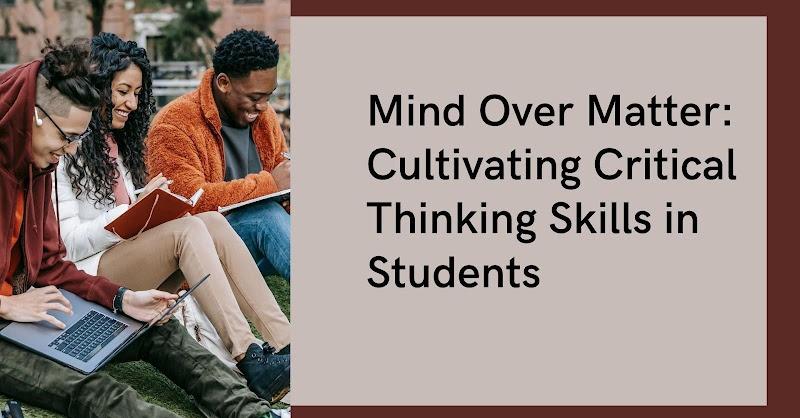The proliferation of misinformation and complex issues in our increasingly chaotic world underscores why critical thinking abilities are so essential for students to thrive academically, professionally, and personally. Critical thinking empowers students to analyze multilayered problems objectively, synthesize diverse perspectives, separate facts from falsehoods, and derive innovative solutions.
With its far-reaching benefits, the purposeful cultivation of critical thinking skills in students constitutes one of the most valuable investments we can make in shaping future generations. However, while most educators agree that developing critical faculties is crucial, tangible frameworks and strategies for implementation often remain unclear.
By systematically exploring the core components of critical thinking, identifying potential obstacles, and employing nurturing pedagogies, we can equip students with this indispensable cognitive skill set. Let’s examine how to lay the foundations and provide scaffolding for students to blossom into discerning, rational thinkers.
Why Critical Thinking Matters Now More Than Ever
Critical thinking constitutes one of the most universally valued skills in our volatile and complex world. An overwhelming 94% of people believe critical thinking abilities are extremely or very important, according to a study by Simmons University. However, 86% find these skills sorely lacking in the general public.
The magnitude of this deficit indicates that we have significant work to do in fostering critical thought. But first, why does it matter so much in the first place?
It Promotes Independent Thought
Critical thinking centers students within their thought processes rather than external influences. By teaching structured ways to objectively evaluate ideas, students gain confidence in forming their own opinions rather than blindly accepting narratives. Online science tutors can help make these concepts engaging through experiments.
It Enables Wise Decision-Making
Life presents infinitely complex choices. Critical thinking allows rationally weighing options when faced with pivotal decisions on careers, relationships, finances, and more. It provides clarity amid confusion.
It Creates Perspicacity and Skillfulness
Sharpened critical faculties allow discerning the crux of multifaceted real-world problems, cutting through biases and misdirections. It enables responding to issues thoughtfully and skillfully.
While lauding its merits is easy, comprehensively grasping critical thinking requires first exploring foundational models that elucidate this elaborate cognitive process. This leads us to one such cornerstone framework called the Five Rs.
Democratizing Critical Thought Through the Five Rs
The Five Rs framework provides a sequenced blueprint for developing holistic critical thinking skills across diverse contexts. The steps enable neutrally digesting information and then deliberately analyzing, re-evaluating, and responding to it rationally.
1. Receive
Being open-minded to accept new information and perspectives without prejudice or jumping to conclusions is key. It allows objectively analyzing issues even if they contradict one’s beliefs. Students should use empathy and see opposites when receiving new viewpoints.
2. Research
Thoroughly researching issues from credible sources across the spectrum forms the basis of sound analysis. Students need guidance to distinguish trusted sources and detect misinformation. They should learn to dig deeper, questioning what lies beneath the surface.
3. Restructure Thinking
One must evolve their thinking and assumptions continuously based on new evidence uncovered during ongoing research. It’s important to avoid clinging to existing beliefs when faced with countering facts. Students should be willing to update working hypotheses.
4. Respond
Critical thinking enables informed and intentional actions instead of impulsive reactions. With social media, students increasingly react first and reflect later. Guiding them to research comprehensively before responding fosters positive habits.
5. Reflect
Analyzing the outcomes and impacts of actions taken after critical consideration is crucial for learning and growth. By journaling and discussing reflections, students build accountability and refine thinking processes through experiential insights.
Equipping young learners with structured thinking frameworks provides the cognitive tools to absorb information multidimensionally rather than on surface levels. Our next imperative is strengthening the delivery of this empowering mental model.
Teaching Critical Thinking in the Digital Age
Interestingly, the very technologies that grant unfettered access to information are also blamed for undermining students’ critical thinking skills. In a study by the University of Melbourne, technology was identified as the prime factor (29%) behind deficits in critical thought and analysis, followed by societal (28%) and educational (22%) influences.
While it is true that social media spreads misinformation and propaganda rapidly, the sheer breadth of digital information also exposes students to more diverse perspectives. The objective analysis of data, facilitated by analytics and algorithms, indeed enhances critical examination. However, for learners to experience these benefits, they require structured guidance in using technology mindfully.
In today’s world, where smartphones and social media platforms often lead to information overload, critical thinking emerges as crucial armor for navigating through this deluge. With misinformation packaged convincingly and doctored images distorting reality, truth detection and objective analysis are essential literacies. Next, let’s explore best practices for educators to instill these within mainstream academics.
12 Strategies to Foster Critical Thinking in Academics
While most educational institutions acknowledge that critical thinking merits dedicated cultivation, tangible implementation often lags behind the intent. Based on proven frameworks and teaching methods, here are 12 tips to permeate critical thinking systematically across grades and subjects:
1. Introduce structured thinking models early
Familiarize students with organized thinking frameworks like the Five Rs through bite-sized lessons starting elementary school using relatable, real-world examples.
2. Set collaborative group projects
Assign interdisciplinary research projects on societal issues that require objective analysis, reasoned opinions, and creative solutions. The process is as important as the final product.
3. Host debates around controversial issues
Have students respectfully debate divisive topics and try arguing opposing sides. This builds empathy while mitigating confirmation bias.
4. Ask probing Socratic questions
Incorporate open-ended questions that test logic, reasoning, and evidence-based arguments across topics. Socratic questioning builds critical dialogue.
5. Teach vetting reliable sources
Show students how to vet credibility and catch doctored media through reverse image searches, lateral reading, researching references, etc. These build information literacy.
6. Require extensive research
Set assignments like annotated bibliographies and citation analysis requiring extensive quality research and comparison of sources.
7. Discuss real-world issues
Promote open peer discussions around societal, ethical, and environmental issues. Ask students to identify potential influences, biases, and self-interests that color different stances.
8. Teach statistical literacy
Statistical analysis lies at the heart of rational thinking and busting misinformation. Provide a foundation in statistical concepts, methods, and tools to derive insights from data.
9. Foster media literacy
Teach students how to analyze the purpose, target audience, techniques, biases, and credibility of online content, social media, advertisements, influencer marketing, etc.
10. Show counter viewpoints
When introducing opinions, be sure to also present credible contradictory evidence and alternative interpretations to build holistic evaluation skills.
11. Test reasoning ability
Design exams and assignments that evaluate objective reasoning aptitude rather than just the ability to recollect facts and content.
12. Make it cross-curricular
Work with educators across disciplines to integrate frameworks, resources, and practices that foster critical thinking within diverse subjects.
The ultimate goal is to groom engaged citizens who can rationally analyze the intricate issues facing humanity. By instilling structured critical thinking skills early and reinforcing them throughout academics, students develop the acumen to navigate the world.
Overcoming Roadblocks Along the Critical Thinking Journey
However, the road to imparting bulletproof critical thinking faces potential bumps. By acknowledging common obstacles proactively, we can preempt and mitigate them.
- Bias Tendencies – All humans harbor intrinsic biases. Teachers should spot and help students recognize biases that cloud objective reasoning. Open-mindedness is key.
- Tenacity to Existing Beliefs – Letting go of assumptions is difficult. By requiring credible evidence and emphasizing the ongoing evolution of knowledge, stubborn clinginess can be reduced.
- Discomfort With Complexity – Critical thinking entails sitting with multifaceted issues patiently. Provide scaffolding to build tolerance for complexity and ambiguity.
- Aversion to Conflict – Teach civil disagreement and reasoning over-reactive arguments. Different perspectives are pivotal to broadening thinking.
- Lack of Research Skills – Instill meticulous research strategies encompassing source credibility, lateral reading, contextualization, and citation tracking.
- Loss of Focus – In a distracting digital era, build students’ concentration and metacognition surrounding focus. Attention discipline thinking.
Guiding students compassionately as they navigate these learning curves while creating safe spaces for transparent dialogue and growth, will enable cultivating critical thought amidst obstacles.
FAQs on Critical Thinking
How can schools integrate critical thinking into mainstream academics?
Start with foundational frameworks like the Five Rs through bite-sized lessons. Set collaborative assignments that require research and objective reasoning. Foster debates and discussions. Ask thought-provoking questions. Assess reasoning skills. Mainstream it across subjects and grades.
Can social media be harnessed to strengthen critical thinking?
While social platforms rapidly spread misinformation, their reach also exposes students to diverse views. With guidance in objective analysis, social media can foster critical thinking by connecting users worldwide. Teens need help using it mindfully.
How can critical thinking help students respond to real-world issues?
The rational analysis of intricate problems prepares students to respond effectively to issues like inequality, climate change, global conflicts, etc. Critical thinking allows generating innovative, ethical solutions to seemingly intractable systemic challenges facing humanity.
Key Takeaway
Our rapidly evolving world, fraught with complex social challenges and modern misinformation, urgently requires the next generation to possess sound critical thinking abilities. While most educators agree that critical faculties are imperative for students to thrive in academics, careers, and life, tangible teaching frameworks have been slower to emerge.
By methodically nurturing critical thinking skills starting young using structured models, open-minded research, reasoned perspective taking, and analytical response generation, we can equip students to navigate convoluted issues adeptly. Scaffolding these metacognitive abilities and addressing hurdles with compassion lays robust foundations.
Critical thinking fuels innovation, truth-seeking, wisdom, and positive change. While cultivating it requires vision and diligence, the payoffs are immeasurable for shaping tomorrow’s engaged citizens and compassionate trailblazers. As educators, it is incumbent upon us to groom judicious thinkers who can pierce through Noise and perceive truth unclouded by agendas. Because logic is the antidote to lunacy, and we need it now more than ever.






